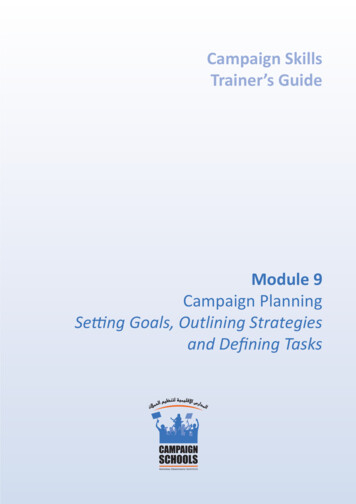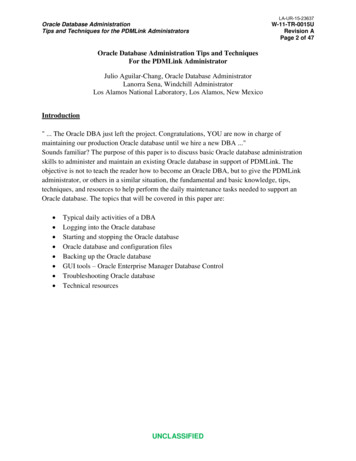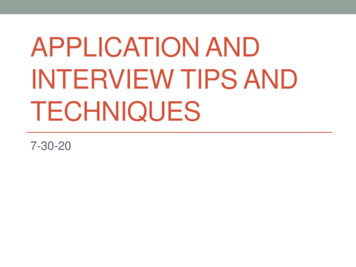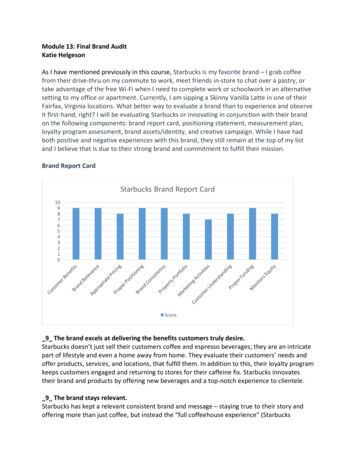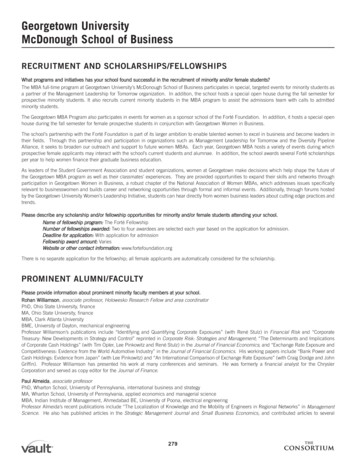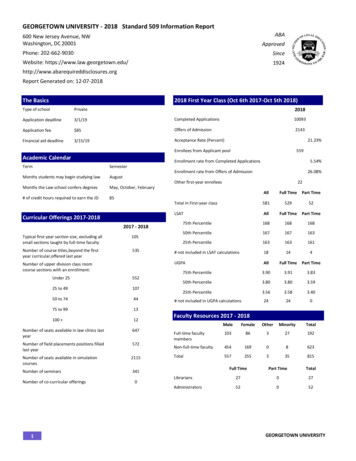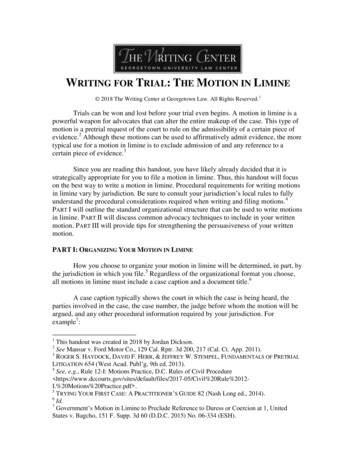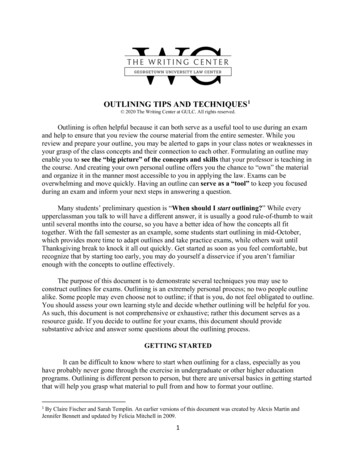
Transcription
OUTLINING TIPS AND TECHNIQUES 1 2020 The Writing Center at GULC. All rights reserved.Outlining is often helpful because it can both serve as a useful tool to use during an examand help to ensure that you review the course material from the entire semester. While youreview and prepare your outline, you may be alerted to gaps in your class notes or weaknesses inyour grasp of the class concepts and their connection to each other. Formulating an outline mayenable you to see the “big picture” of the concepts and skills that your professor is teaching inthe course. And creating your own personal outline offers you the chance to “own” the materialand organize it in the manner most accessible to you in applying the law. Exams can beoverwhelming and move quickly. Having an outline can serve as a “tool” to keep you focusedduring an exam and inform your next steps in answering a question.Many students’ preliminary question is “When should I start outlining?” While everyupperclassman you talk to will have a different answer, it is usually a good rule-of-thumb to waituntil several months into the course, so you have a better idea of how the concepts all fittogether. With the fall semester as an example, some students start outlining in mid-October,which provides more time to adapt outlines and take practice exams, while others wait untilThanksgiving break to knock it all out quickly. Get started as soon as you feel comfortable, butrecognize that by starting too early, you may do yourself a disservice if you aren’t familiarenough with the concepts to outline effectively.The purpose of this document is to demonstrate several techniques you may use toconstruct outlines for exams. Outlining is an extremely personal process; no two people outlinealike. Some people may even choose not to outline; if that is you, do not feel obligated to outline.You should assess your own learning style and decide whether outlining will be helpful for you.As such, this document is not comprehensive or exhaustive; rather this document serves as aresource guide. If you decide to outline for your exams, this document should providesubstantive advice and answer some questions about the outlining process.GETTING STARTEDIt can be difficult to know where to start when outlining for a class, especially as youhave probably never gone through the exercise in undergraduate or other higher educationprograms. Outlining is different person to person, but there are universal basics in getting startedthat will help you grasp what material to pull from and how to format your outline.By Claire Fischer and Sarah Templin. An earlier versions of this document was created by Alexis Martin andJennifer Bennett and updated by Felicia Mitchell in 2009.11
1. Gather your resources.Outlining, fundamentally, is about pulling together all the resources you have gatheredthrough the semester to build a master document to use on the final exam. These resources maybe made by you, your professor, another student, or available commercially. Resources fromyour specific class like class notes are the most useful, as material covered in class is the mostlikely to appear on an exam, though resources like model outlines from prior years of yourprofessor’s class can help organize and fill in gaps in your own outline. Your professor’ssyllabus can be used to understand how to organize the class, especially if organized topically. Amodel outline is an outline that another student previously made for the same class with the sameprofessor. To find a model outline, use your resources: the Student Bar Association outline bank,friends, peer advisors, law fellows, and upperclassmen in student organizations.Most students will use their syllabus or a model outline to instruct how to build theframework of their outline, add material to the framework with their class notes, and fill in anygaps with their casebook, model outlines, and commercial supplements. Getting all of thesematerials ready before you start outlining (i.e., typing your class notes if you hand wrote themand having any online materials downloaded) will streamline the process.2. Decide on the formatting for your outline.Because outlining is extremely personal, no two outlines will look the same, but there aresome formats that are popular. Looking through model outlines can show you some examples ofpopular formats. Don’t be afraid to combine diagrams with a traditional outline. Some materialmay lend better to one format than other material in the same class. There are a number ofcomputer software resources available that might help you while outlining. Though moststudents rely on basic word processing programs, such as Word or Google Docs, you mayconsider using other programs to create tables, flowcharts, or other diagrams, includingLucidChart and PowerPoint. Outline format: it is called outlining for a reason! An outline format organizesinformation in a hierarchy using alpha-numerics or bullets (think of a traditionalroman numeral outline). This format helps students understand how subtopics(i.e., the elements of negligence) fit into the overall topic (i.e., negligence). Charts/Diagrams: Using charts and diagrams is a more interactive way to displayinformation. For example, a flowchart of the step-by-step analysis of negligencemay ensure you do not miss an element in your analysis in the exam. Manystudents place case briefs for important cases into boxes within their outline toseparate them from the black letter law. Although, it can be difficult to display allthe necessary information in a flowchart or diagram.To make an effective outline to use for an exam, using eye-catching and useful featureswill help organize the material. Bolding and highlighting can draw your eye to key terms orideas that are important to find when scrolling or flipping through your outline. Constructing aclickable Table of Contents can allow you to easily jump between sections. If you’re only2
allowed a physical copy, physically tabbing the document can serve the same function. Finally,using keywords in the headings allows you to use the search functions in your word processingsoftware (i.e., the Find function in Word).CREATING A FRAMEWORKWhen you begin creating your outline, developing the framework of the outline first can beextremely effective. Organizing the structure before you begin to fill in the details may help yousee the big picture of the course and discover any class notes you may be missing. Focus onorganizing these sections in a way that will allow you to apply the law in an exam and utilizeheadings effectively to do so.1. Divide your outline into key “topics,” “sections,” or “steps.”To do this, identify and write down the main “sections” or “topics” of your outline beforefilling in any detail from your notes. Your main sections should be broad, general points. Thismay be done by separating the course into key “topics” or “sections” covered in your syllabus(i.e. Intentional Torts and Unintentional Torts), or into different “steps” in the application of thelaw (i.e. Offer, Acceptance, Consideration). Some students organize their outlines based onsubstantive black letter law, others focus on procedural steps, whereas some choose to combineboth approaches.One option is to use your course syllabus to create the framework of your outline. Someprofessors give out syllabi in outline form. If you are lucky enough to get a syllabus organized inoutline form, it is often an effective framework for your outline because it is organized in theexact manner that you learned the material and in the exact manner your professor understandsthe material. However, if the syllabus framework does not track how you would apply the law inan exam, do not be afraid to deviate from it.If you decide to use a model outline, it can be a good tool to help you create theframework for your own outline. Once you read through the model outline, determine whetherthe large headings are structured in a way either you thought the course was structured or isunderstandable to you, and use the points that make the most sense to you.2. Organize each section according to application of the law.Regardless of the framework you choose, it is important that it guides you through ananalysis of the legal questions potentially at issue in your exam. Although an outline can just be ahelpful way to review all the material, because you are putting so much time and effort into thedocument, why not make it useful in an exam, as well? By allowing your framework to trackthe way you would apply the law, you can quickly refer back to it in an exam if you get stuckin the middle of a question and don’t know how to proceed. Consider looking at model or“best” exam answers to see the order in which that student worked through the analysis.3
After you select your main topics or sections, begin subdividing these into smaller subsections that will continue to move the analysis along. The analysis of a torts problem isillustrative.1.EXAMPLE: TortsWhat is the tort at issue? 1. Batteryo Are the elements satisfied? A. Intent B. Contact C. Harm / injuryo Is there a defense? 2. Negligenceo Are the elements satisfied? Duty Breach of duty Causation But-for causation Proximate causation Injuryo Is there a defense?2. Damages / Liability? Joint & several liability Several liability3. Use headings effectively.Headings can be a useful way to organize a document and make it more reader-friendly,but they can also be an effective way to organize your analysis. One example of utilizingheadings is by posing them as questions. It may seem obvious or trivial but posing headings as aquestion can quickly provide you language to start writing the next step of analysis in an exam.For example, by including the headline “What is the tort at issue?,” you can easily begin writingon an exam, “The tort at issue is [battery] because . . .” Once you complete your outline,consider reading through just the headings. Do they walk you through the legal analysis? If not,do they serve another purpose? These headings can also be the basis for your “attack outline” or“checklist,” which will be discussed in more detail below.FILLING IN DETAILSOnce you have a framework of the key topics of the course, you can continue to putinformation in your outline that gets more and more specific by filling in the details with blackletter law, cases, and policy arguments. Use your notes, casebook, supplemental materials, andwhat your professor has said throughout the semester for assistance in deciding what is importantwhen taking the exam and thus should be included in your outline. Also, you may find it helpfulto color code each different type of detail (i.e. cases, policy arguments) to distinguish them asyou construct your outline.4
Black letter law. Even though professors and casebooks tend to “hide the ball” with whatrules to distill from cases, your outline should be primarily based on black letter law and rules.Pay particular attention to how you write rules within your outline--you want succinct andaccurate rule statements to use for your exam. If your professor has a specific way of wordinga rule of law, be sure to use that language. By having succinctly stated rules within your outline,you will be able to easily rewrite the rule from your outline or memorize it if your exam is closedbook.Organizing circuit splits, exceptions, and factor tests can be more difficult than simplerule statements, but these are all nuances that are necessary for an accurate outline. Includingexceptions close to the original rule will ensure you cover more issues in an exam. It can behelpful to clearly denote which rule is the majority rule and which is the minority rule to avoidconfusion in your outline. Also, clearly showing when something is an elements test (i.e.,proving negligence) and when something is a factor-based test (i.e., 4th Amendment searchtotality of the circumstances) will help you accurately apply the test on your exam, as theyrequire different applications.Cases. Students take different approaches in incorporating cases from class into theiroutlines. While full case briefs are rarely necessary, including case names can help you tounderstand the concepts that the case stands for. It may be beneficial to note seminal cases thatyour professor emphasizes and to refer to specific authority if your class is heavily case-oriented.If your professor asks for citations or references to cases in exam answers, noting case namesnear the rule of law the case stands for and including some facts from cases in your outline mayhelp you to analogize the exam question facts to the case. However, do not feel obligated toinclude case names in your outline if you do not feel it will help you to learn the material and ifyour professor doesn’t require them.Policy. Policy arguments include many different types of arguments: economic theory,justification for certain laws, and the effects of laws. The types of policy arguments to include inyour outline largely depend on your professor. Think about the discussions you had during classabout the “why” behind the law. It can be helpful to include the policy arguments that yourprofessor uses the most in class discussions in your outline to add additional policy arguments toyour exam answers. While the basis of your exam answers will come from black letter law,including policy arguments based on your outline can help add more points to your answer.Using the Torts example discussed above, here are some details you may fill in:5
1.Battery EXAMPLE: TortsOccurs when one intends and inflicts harmful or offensive unwanted contact with another personwithout that person’s consentAre the elements satisfied?o A. Intent Actor must desire to cause consequences from his act or be substantiallycertain that they will result Reasons do not need to be rational (i.e. mental illness, crazy choice) Dual intent v. single intent Policy: If cann
If you decide to use a model outline, it can be a good tool to help you create the framework for your own outline. Once you read through the model outline, determine whether the large headings are structured in a way either you thought the course was structured or is understandable to you, and use the points that make the most sense to you. 2. Organize each section according to application of the law.
